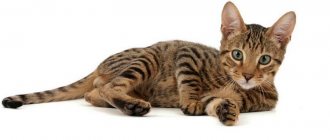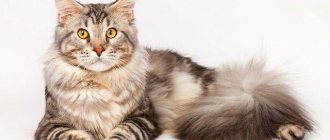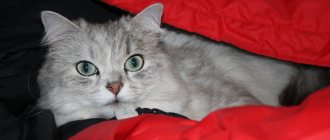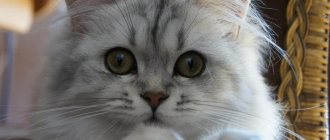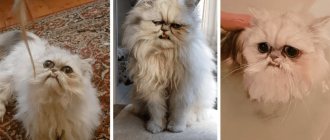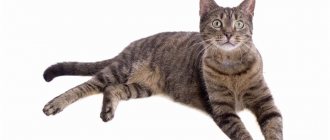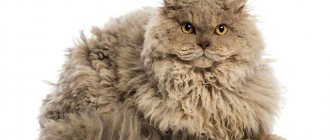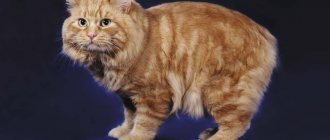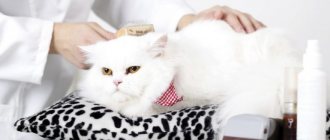For cats, as well as for other animals, smell is one of the most important senses, even despite the cat's famous vision.
After all, you may not see the prey, but you can smell it. By smell you can find out if someone was on their territory, and who exactly it was. By and large, smell can be considered the second sight of animals, it plays such an important role in their lives.
Smell is everything to a cat
It all starts from the very first days of life. After all, newborn kittens are completely blind. How then do they unmistakably find the mother cat’s milk nipples? Of course, by smell. By smell, the mother cat herself distinguishes kittens from the same litter, and the kittens themselves distinguish each other and all surrounding objects.
Cats mark their territory using special odorous liquids that are secreted by glands on their faces and near their tails. This is why cats often rub their faces against objects. Including the owners, they also mark them as something that is located on their territory and is their property.
Cats find a cat that is ready to mate by smell, and cats find the cat that is most suitable for them. The smell also identifies whose territory the cat is currently in, or whether a stranger is present in his own possessions.
Parting with familiar smells causes quite a lot of stress in a cat. That’s why your pets have such a hard time going through moving, buying new furniture, and especially renovations. After all, if when moving or buying a new sofa the smells remain more or less natural, then during renovation the smells of paints and other building materials can simply drive the poor animal crazy. Therefore, during the period of reconstruction, it is better to take the cat to the dacha or to another house.
It should be noted that the shape of cat noses depends on the breed. It is clear that the nose of a Siamese or Siberian cat will be much larger than the nose of a Persian. And the hump nose of a Burmese cat can be safely described as aristocratic or “Roman”.
Cat nose device
A cat's nose, like a human's, consists of two nasal canals separated by cartilage. When a cat inhales air, it enters special nasal chambers. There he passes through winding channels, lingering in them for some time. During this retention of air in these channels, odors are recognized.
The cells responsible for recognition are bottle-shaped and end in several sensory hairs. And the hairs are covered with mucus, in which all odorous substances dissolve. These analyzer cells are directly connected to the part of the cat's brain responsible for smell.
In addition to the analytical function, the nasal sinuses also perform a kind of filter and air conditioning function. The air passing through them is heated and cleaned of dust and bacteria.
To sniff unfamiliar objects, cats use a specific organ called the Jacobson tube. This tube can simultaneously identify not only smell, but also taste. This organ is located above the upper palate. The cat uses it when it inhales air through its mouth.
This lifts the upper lip and exposes the incisors. Perhaps you could observe this in your pet and remember this rather funny grimace, vaguely reminiscent of a grin.
Although a cat's sense of smell does not reach that of a dog's, it is definitely many times better than a human's. Therefore, your pets can react quite painfully to many odors. Which, by the way, you won’t even feel.
Therefore, you should not wash your cat's bowl with dishwashing detergent. Because what is a barely perceptible pleasant smell for us is something akin to a gas attack for cats. And even if you use detergent, try to rinse out any remaining detergent from the bowl as thoroughly as possible.
Agree, it will be unpleasant for you if someone pours a bottle of perfume into your food. So the cat is unpleasant to the extra odors present in its food and completely suppressing its appetite.
Also, the nose is a kind of indicator of health. Have you heard the expression “a wet nose is a healthy dog”? This also applies to cats. In a healthy animal, the nose should be cool and moist. Humidity is provided with the help of a special secretion and during licking.
In addition, maintaining body temperature at an optimal level also occurs through the nose and oral cavity. After all, cats only sweat the pads on their paws, and this is too little for full heat exchange.
Changes in indicators, as they indicate
Changes in the condition of a cat’s nose can indicate both a change in the condition of its body within the physiological norm, and the development of a serious pathology, which allows the attentive owner to consult a veterinarian in time and prevent possible complications in their beloved animal. The condition of the nose can also be influenced by external factors.
Dry nose and its causes
It is normal for a cat to have a dry nose during sleep, as well as for the next half hour after waking up. This is explained by the fact that the secretion of mucous glands decreases during sleep. If your nose continues to be dry, this is a good reason to perform thermometry.
A dry nose can also occur during stress or after physical activity; During play, the nose can change its state from wet to dry several times, since the nose tends to reflect the reaction of the cat's body to physical activity.
Heat and dry air can also cause a dry nose; under these conditions, moisture evaporates faster from the cat’s nose, and the glands do not have time to replenish lubrication. The cat will lick itself frequently in an attempt to compensate for the moisture. You need to make sure that your cat always has drinking water to replenish the lack of fluid.
With fever, the nose becomes dry and also hot for a long time; this is due to both elevated body temperature and the lack of fluid in the body that accompanies fever. Fever is an increase in the cat's body temperature above 39 °C. All cases of fever are a reason to consult a veterinarian.
Some cats are prone to dry noses due to their breed, such as Bengals.
It is worth paying attention to the discharge from the cat’s nose; Normally they are not present, and they have nothing to do with normal nasal lubrication. Exuding from the nasal passages, they stain the fur and form crusts. The cat sneezes, its sense of smell is dulled, which leads to loss of appetite. Nasal discharge should never be ignored. Thus, viral infections at the onset of the disease are characterized by mucous, transparent nasal discharge; when bacterial flora is added, the discharge becomes purulent. A mucous discharge from only one nostril may indicate the presence of a foreign body that the cat could accidentally inhale, as well as a polyp in the nasal cavity. In the presence of a tumor, discharge from one nostril mixed with blood is typical. The allergy is characterized by profuse, clear nasal discharge. In case of injury, nosebleeds may develop. The presence of nasal discharge in a cat is always a reason to contact a veterinarian.
Warm or cold: what affects temperature
First of all, this is influenced by subjective perception, since the difference in body temperature between a cat and a human is approximately 2 °C. Next are the factors discussed above that cause dry nose; because the water evaporating from the secretions of the nasal glands causes the nose to cool. The temperature of the nose and its humidity are closely related; for example, at the very beginning of a cold, when a fever begins, the nose may already be warm, but still wet. If the fever persists, the nose will become dry and hot.
There is one ominous symptom associated with the temperature and humidity of the cat’s nose. This is a wet and very cold nose. Such a nose occurs due to acute circulatory failure - shock; which may be caused by low temperature, burns, electrical shock, allergies, poisoning, injury, inflammatory disease or other reasons. Shock is necessarily accompanied by depression of the cat’s consciousness and physical activity. The mucous membranes available for inspection are pale or bluish in color; pulsation in the main arteries is weakened, ears and paws are cold, breathing is shallow. Shock is a life-threatening condition; the cat must be urgently taken to the nearest veterinary hospital with intensive care. Before transporting, call the clinic, this will ensure the readiness of the resuscitator; wrap the cat in something warm; if the cause was injury, ensure immobility during transportation by placing it on a smooth hard surface (board) on its side; monitor the cat's condition over time. It is important to act extremely quickly; cats, unlike people and dogs, resist shock very poorly.
Photo gallery about nasal discharge in cats:
A small amount of mucous discharge may indicate the onset of an infectious disease or allergy
Abundant purulent discharge from the nose indicates the participation of bacterial or fungal flora in the disease
Nosebleeds are most often seen with injuries; may occur due to poisoning by rat poison
Nose color and spots
The nose can be pigmented, without pigment, as well as with congenital pigment spots, which have a constant size, shape, color, and are covered with unchanged nasal skin.
If the nose is without pigment (pink), then by the change in its color one can judge changes in the blood flow and even the composition of the blood in the capillaries (the smallest blood vessels), which in the area of the nose are located very close to the surface of the skin; So, with a decrease in blood pressure, anemia, the nose becomes pale; with insufficiency of heart or lung function - cyanotic; with inflammation of the liver with jaundice, the nose may acquire a yellowish tint due to the increased content of bilirubin pigment in the blood; with allergies, the nose turns red. If the nose is pigmented, then such an express diagnosis is not available, however, you can pay attention to the non-pigmented mucous membranes of the mouth and eyes; getting to them is a little more difficult, but the changes will be the same. Any sudden change in the color of the cat’s nose and mucous membranes is a reason to consult a veterinarian.
In addition to congenital pigment spots, young animals may develop multiple pigment spots on the nose, as well as on the mucous membranes and abdomen. This lentigo, a non-dangerous condition, is determined by heredity. In animals over 8 years of age, dark pigment spots may appear on the nose, associated with chronic photodamage from sunlight. Cats with a non-pigmented nose are especially susceptible. Usually these spots are harmless, but it is worth paying attention to monitoring them; since in some cases they serve as a source of development of squamous cell skin cancer. The good thing is that this form of cancer develops gradually, and an attentive owner will always contact a veterinarian, and the cat will be cured. The disease usually begins with the formation of redness and scab (crusts) on the nose. Persistent crusts and redness on a cat's nose can be the initial signs of squamous cell skin cancer - this is a reason to consult a veterinarian. With the development of the disease, in the absence of treatment, the formation of erosions and ulcers is characteristic; and then aggressive tumor growth with destruction of the nose. In the early stages, the veterinarian performs surgical treatment with excision of the tumor and complete recovery; in advanced cases, surgical treatment is also possible, but it will be aimed at improving the animal’s quality of life.
Photo gallery about spots on the nose of cats:
Uneven pigmentation of the nose, characteristic of tortoiseshell cats
Manifestations of lentigo - local melanosis of the skin - on the nose. This is an individual feature of the body. There is no connection with the further development of oncopathology
At the onset of the disease, squamous cell carcinoma looks like a small ulcer covered with a scab. Unlike ordinary injuries, this wound does not heal, and the owner should be wary. If measures are not taken in time, the tumor actively grows, spreading to neighboring tissues
If the tumor has grown, then getting rid of it requires resection of large amounts of tissue. The photo clearly shows rough guiding seams. Such sutures are usually applied to close the edges of the wound in conditions of tissue deficiency. There is a fight for the cat's life
Nose shape
Breeds with shortened, flattened faces deserve special attention. These include Persian cats, as well as short-haired exotics. As a result of selection, these breeds received a pronounced flattening of the facial skull, which led to a predisposition to chronic inflammatory diseases of the upper respiratory tract. The cause is a mechanical interruption of the air flow passing through the shortened and deformed nasal passages, which leads to chronic inflammation of the epithelium. Veterinarians combine a set of diseases associated with the structural features of the facial skull in such animals into brachycephalic syndrome; and insist on mandatory regular monitoring of all cats of brachycephalic breeds (Persian, British, Scottish Fold, Himalayan and others). Representatives of these breeds often have stenosis (narrowing) of the nostrils, which is not noticed by cat owners. This is manifested by decreased activity of cats, shortness of breath after minor physical exertion, and sniffling. Veterinarians often identify this pathology during routine examinations. The treatment is surgical, plastic surgery of the nostrils is performed, and the cat is able to breathe normally. It is very important to treat your cat in the first years of life to prevent further development of the disease.
Photo gallery about the treatment of narrowing of the nasal passages:
The narrowing of the cat’s nostrils prevents the inhalation of air, which leads to shortness of breath and exercise intolerance. Surgical treatment - wedge-shaped resection of the nose - allows you to restore normal breathing. Remarkable results of surgical treatment: the cat’s nose looks great and breathes no less beautifully.
Cat fingerprinting
You've probably noticed that cats' noses are rough. But every cat has its own unique pattern on its nose. This uniqueness is akin to human fingerprints. Just as you can't find two people with the same prints, you can't find two cats with the same nose pattern. This feature can be used to recognize animals.
The color of the nose depends on the color of the cat as a whole. Some cat breeds are distinguished by the fact that their noses have a dark edging. For example, the chinchilla breed can boast of such natural “eyeliner”.
Cat breeds with a flattened face and large eyes
Brachycephaly is a shortened longitudinal diameter of the skull. These cats have a spherical head shape.
There are not many brachycephalic cats registered in felinological organizations. They all have a similar skull structure, but differ from each other in body type, coat length and character.
The most popular among existing breeds of cats with a flattened face are:
- Persian cat;
- exotic;
- Himalayan cat;
- British Shorthair;
- Scottish fold cats;
- wild cat manul.
Persian cat
These fluffy animals with a flattened nose appeared several centuries ago and have not lost popularity since then. They are quite large in size - some individuals can weigh up to 7 kg.
Purebred Persians are easily recognized by their squat body with short legs and unusual flat muzzle with large, expressive eyes. The compact body of snub-nosed cats is covered with luxurious fur, the length of which can reach 12 cm.
Depending on the structure of the skull, the following types are distinguished in the breed:
- classic - with the nose located below eye level;
- modern - with a lobe located in line with the lower eyelid;
- extreme - with a concave nose located level with the inner corners of the eyes.
In addition to its attractive appearance, this cat with a flattened muzzle and large eyes is endowed with a balanced, gentle disposition. True, sometimes the truly royal calm of representatives of the breed can give way to demands and whims.
The snub-nosed Persian prefers to spend most of his time on a soft sofa. So owners of these luxurious, flat-faced cats won't have to worry about tattered curtains or scratched furniture.
Exotic
This flat-faced cat is closely related to Persians and American Shorthairs. It was developed in the United States in the 1960s and quickly achieved breed status. The plush cats with a flattened face were originally called Sterlings, but were later renamed Exotic Shorthairs.
Snub-nosed cats are relatively large in size and weigh up to 7 kg. The distinctive hallmark of the breed is its small, forward-pointing ears, pronounced cheeks and huge, wide-set eyes.
Compact, tightly knit exotics are covered with short, silky, two-layer coat of almost any color.
Squat cats with a flattened muzzle and large eyes are distinguished by a calm and peaceful disposition. Playful and friendly representatives of the breed never show aggression or make unnecessary noise. Snub-nosed cats quickly become attached to their owners and get along with other pets without problems.
Himalayan cat
These owners of a flattened muzzle and large eyes were the result of crossing representatives of the Persian and Siamese breeds. To date, Himalayan cats are not recognized by all felinological organizations. In some associations, kittens of this breed are registered as Persian.
From both ancestors, Himalayan cats took only the best features:
- from the Persians they inherited a flattened nose and luxurious long hair;
- from the Siamese they got blue eyes and a beautiful color-point color.
Snub-nosed Himalayan cats are endowed not only with an interesting appearance, but also with a wonderful character. Representatives of the breed are distinguished by a calm, affectionate and slightly lazy disposition. These fluffy cats with large eyes and a flattened muzzle get along well with children and are patient with all their pranks.
British Shorthair
The name of this popular and widespread breed is known even to those who are far from the world of felinology. The British Shorthair is easily recognized by its rounded, flattened muzzle, large expressive eyes and squat body covered with plush fur of different colors.
These attractive snub-nosed cats are endowed with a balanced and flexible disposition. Neat and intelligent representatives of the breed tolerate loneliness well and lend themselves well to education.
Short-haired cats with large eyes and a flattened muzzle have simply limitless patience and rarely release their claws.
Scottish fold cats
Representatives of this breed are endowed with an unusual appearance. Their main distinguishing feature is their ears that are tilted forward and downward. The closer their tips are in contact with the surface of the head, the more valuable the animal is considered.
The snub-nosed Scottish cat has a moderately flattened muzzle and a powerful body covered with thick, soft hair of different colors.
On a note. The straight-eared Scotsman is called the Scottish Straight. It is used in breeding along with lop-eared representatives of the breed to reduce the risk of sick offspring.
Unpretentious Scots are endowed with a balanced and calm disposition. Representatives of the breed are distinguished by their playful character and high intelligence. These peaceful cats with a flattened muzzle, curled ears and large eyes get along well with children and do not like to be left alone.
Wild cat manul
These representatives of the cat family live in Central Asia. They are considered rare and are included in the Red Book.
The large body of the Pallas cat is covered with thick striped fur. And the flattened shape of the muzzle allows you to breathe through the mouth without weakening the grip of the jaws and without releasing prey from the teeth.


